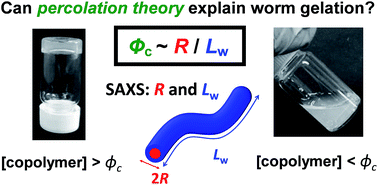当前位置:
X-MOL 学术
›
Chem. Sci.
›
论文详情
Our official English website, www.x-mol.net, welcomes your
feedback! (Note: you will need to create a separate account there.)
Can percolation theory explain the gelation behavior of diblock copolymer worms?†
Chemical Science ( IF 7.6 ) Pub Date : 2018-08-02 00:00:00 , DOI: 10.1039/c8sc02406e Joseph R Lovett 1 , Matthew J Derry 1 , Pengcheng Yang 1 , Fiona L Hatton 1 , Nicholas J Warren 2 , Patrick W Fowler 1 , Steven P Armes 1
Chemical Science ( IF 7.6 ) Pub Date : 2018-08-02 00:00:00 , DOI: 10.1039/c8sc02406e Joseph R Lovett 1 , Matthew J Derry 1 , Pengcheng Yang 1 , Fiona L Hatton 1 , Nicholas J Warren 2 , Patrick W Fowler 1 , Steven P Armes 1
Affiliation

|
It is well known that polymerization-induced self-assembly (PISA) offers an efficient synthetic route for the production of highly anisotropic diblock copolymer worms. When prepared in aqueous media, such worms form thermoresponsive free-standing hydrogels that are (i) readily sterilizable, (ii) can act as a 3D matrix for the culture of normal mammalian cells and (iii) can induce stasis in human stem cell colonies. Herein we critically examine the gelation behavior of two types of diblock copolymer worms in terms of recent advances in percolation theory for rigid rods, which explicitly account for the effect of rod length polydispersity. More specifically, we use small-angle X-ray scattering (SAXS) to determine the weight-average worm contour length, Lw, and the mean worm cross-sectional radius, R. This approach enables a direct comparison to be made between the theoretical critical worm volume fraction, ϕc, required for gelation and the experimental values indicated by rheological measurements and tube inversion experiments. Given that these diblock copolymer worms are relatively flexible rather than truly rod-like, reasonably good agreement between these two parameters is observed, particularly for shorter, relatively stiff worms. For longer, more flexible worms a proportionality constant of approximately two is required to reconcile theory with experimental values for ϕc. These findings are expected to have important implications for the aqueous gelation behavior exhibited by various other anisotropic nanoparticles, such as cellulose nanocrystals and semicrystalline block copolymer rods, and also fibril-forming small molecule (e.g. dipeptide) gelators.
中文翻译:

渗透理论可以解释二嵌段共聚物蠕虫的凝胶行为吗?†
众所周知,聚合诱导自组装(PISA)为生产高度各向异性二嵌段共聚物蠕虫提供了有效的合成路线。当在水性介质中制备时,此类蠕虫会形成热响应性独立式水凝胶,其 (i) 易于灭菌,(ii) 可以作为正常哺乳动物细胞培养的 3D 基质,并且 (iii) 可以诱导人类干细胞集落的停滞。在这里,我们根据刚性棒渗流理论的最新进展,批判性地研究了两种二嵌段共聚物蠕虫的凝胶行为,该理论明确地解释了棒长度多分散性的影响。更具体地说,我们使用小角 X 射线散射 (SAXS) 来确定重量平均蠕虫轮廓长度L w和平均蠕虫横截面半径R 。这种方法可以在凝胶化所需的理论临界蠕虫体积分数Φ c与流变测量和管反转实验表明的实验值之间进行直接比较。鉴于这些二嵌段共聚物蠕虫相对柔性而不是真正的杆状,观察到这两个参数之间相当好的一致性,特别是对于较短的、相对刚性的蠕虫。对于更长、更灵活的蠕虫,需要大约为 2 的比例常数来使Φ c的理论与实验值一致。 这些发现预计将对各种其他各向异性纳米粒子(例如纤维素纳米晶体和半结晶嵌段共聚物棒,以及形成原纤维的小分子(例如二肽)胶凝剂)表现出的水胶凝行为产生重要影响。
更新日期:2018-08-02
中文翻译:

渗透理论可以解释二嵌段共聚物蠕虫的凝胶行为吗?†
众所周知,聚合诱导自组装(PISA)为生产高度各向异性二嵌段共聚物蠕虫提供了有效的合成路线。当在水性介质中制备时,此类蠕虫会形成热响应性独立式水凝胶,其 (i) 易于灭菌,(ii) 可以作为正常哺乳动物细胞培养的 3D 基质,并且 (iii) 可以诱导人类干细胞集落的停滞。在这里,我们根据刚性棒渗流理论的最新进展,批判性地研究了两种二嵌段共聚物蠕虫的凝胶行为,该理论明确地解释了棒长度多分散性的影响。更具体地说,我们使用小角 X 射线散射 (SAXS) 来确定重量平均蠕虫轮廓长度L w和平均蠕虫横截面半径R 。这种方法可以在凝胶化所需的理论临界蠕虫体积分数Φ c与流变测量和管反转实验表明的实验值之间进行直接比较。鉴于这些二嵌段共聚物蠕虫相对柔性而不是真正的杆状,观察到这两个参数之间相当好的一致性,特别是对于较短的、相对刚性的蠕虫。对于更长、更灵活的蠕虫,需要大约为 2 的比例常数来使Φ c的理论与实验值一致。 这些发现预计将对各种其他各向异性纳米粒子(例如纤维素纳米晶体和半结晶嵌段共聚物棒,以及形成原纤维的小分子(例如二肽)胶凝剂)表现出的水胶凝行为产生重要影响。











































 京公网安备 11010802027423号
京公网安备 11010802027423号